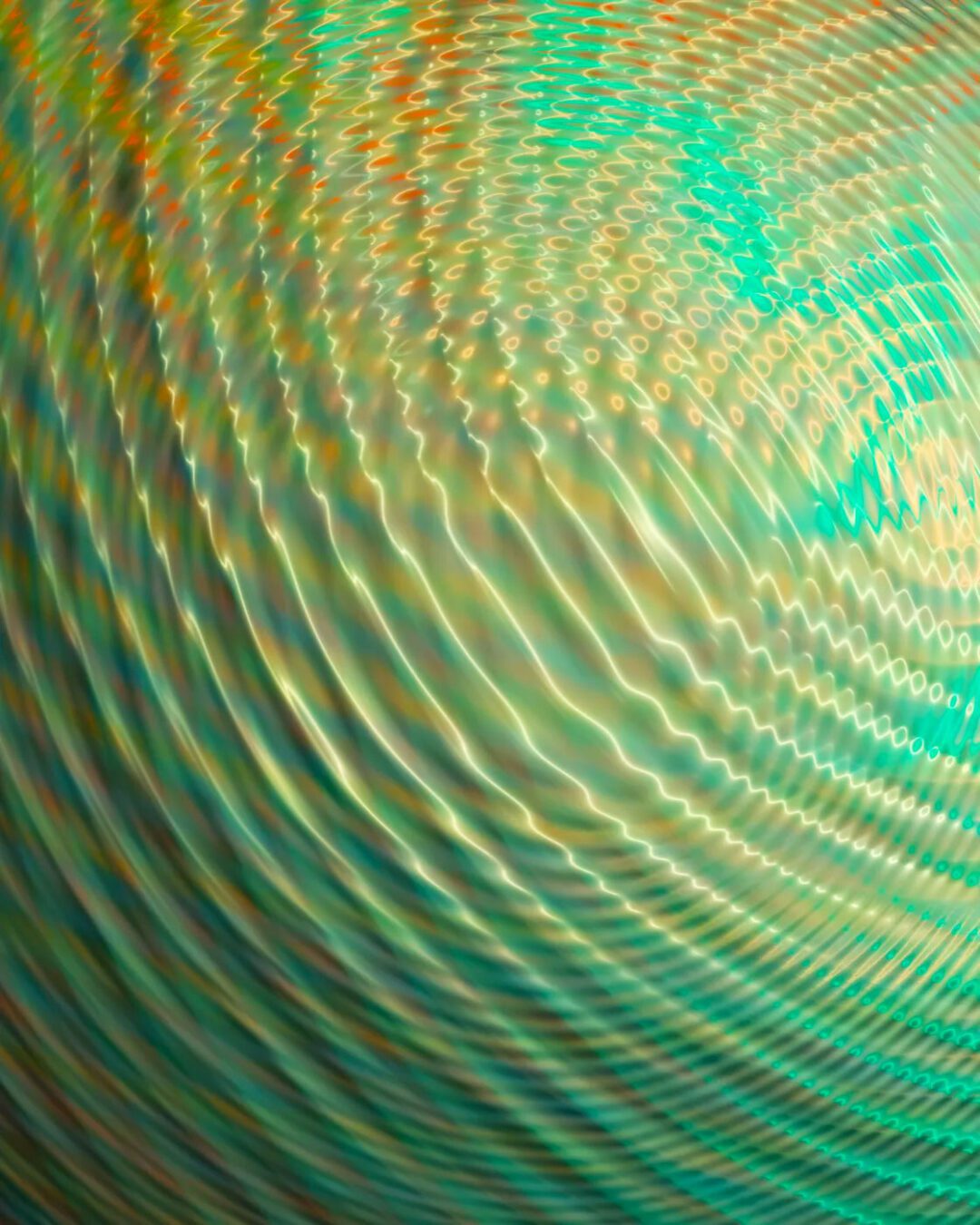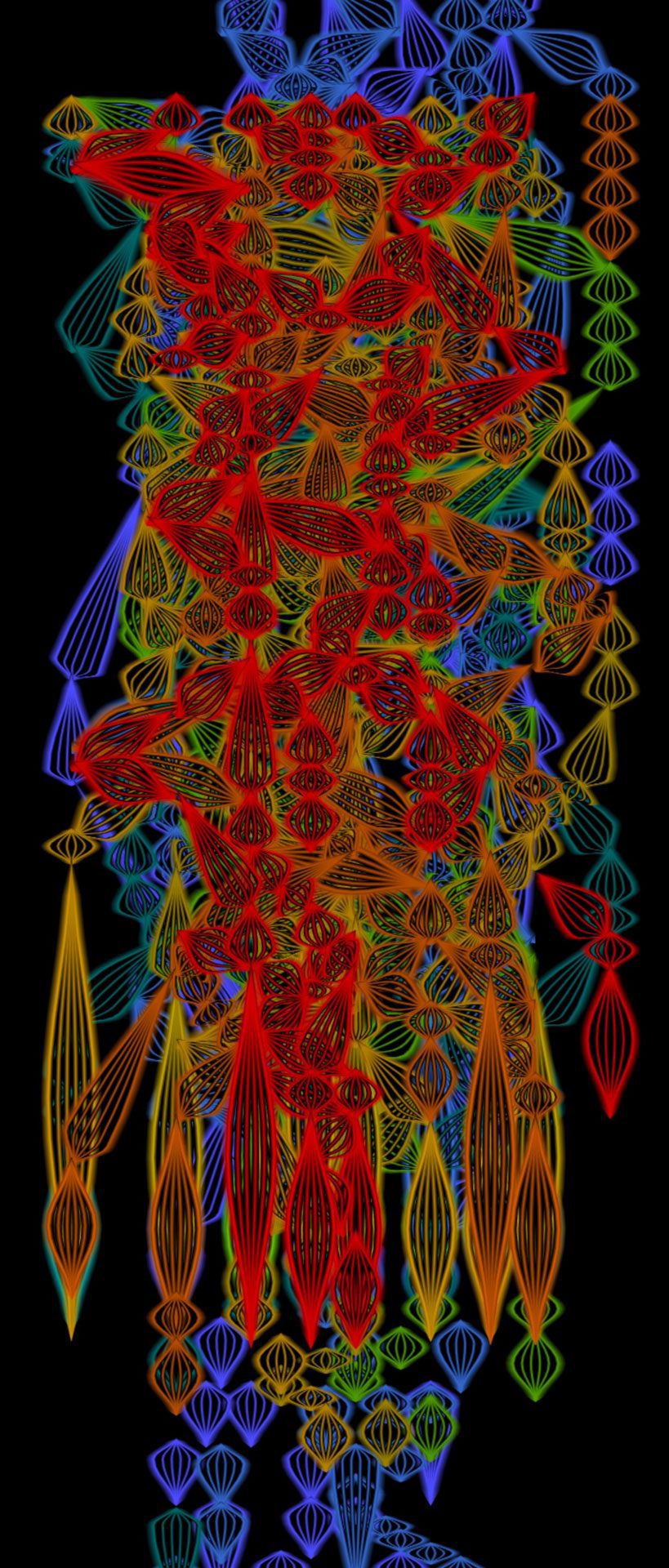Módulo 0: Umbral / Entrada
Percepción en el Centro: El Cuerpo como Punto de Partida del Audio Inmersivo

Zachary Lieberman – Ripple Study #4 – 2024
El desafío principal es crear un trabajo que conmueva a las personas a un nivel emocional , en lugar de hacer que piensen en la tecnología o se pregunten cómo fue creado.
Hacer poemas, no demos
crear obras que sean breves pero intensas, rítmicas y significativas,
en lugar de una demostración que parezca tecnología por el simple hecho de la tecnología.
Zach Lieberman – Artista Multimedia
Introducción.
Antes de hablar sobre el sonido, necesitamos hablar sobre el espacio.
Porque el sonido
existe en relación,
existe dentro de un entorno,
existe entre los cuerpos.
Sin espacio, no hay resonancia.
Sin resonancia, no hay percepción.
Y sin percepción, no hay experiencia.
El espacio no es un recipiente vacío que deba llenarse.
Es una condición activa:
define lo que se escucha, cómo se escucha,
y, sobre todo, desde dónde se escucha.
Trabajar con sonido es intervenir en la arquitectura de la escucha.
Es moldear el tiempo a través del movimiento.
Es construir relaciones entre presencia y ausencia.
Y el espacio es el campo de acción.
Ya en 1906, el matemático y físico teórico Henri Poincaré cuestionó la comprensión del espacio, enfatizando la imposibilidad de imaginar un espacio vacío.
“Es imposible imaginar un espacio vacío; todos nuestros esfuerzos por representar un espacio puro —uno del que se excluyan las imágenes cambiantes de los objetos materiales— solo pueden resultar en una representación donde las superficies vívidamente coloreadas son reemplazadas por líneas débilmente coloreadas, y no podemos llevar esto hasta el final sin que todo desaparezca y termine en la nada.”
En otras palabras, un espacio existe porque tenemos referencias, porque podemos decir que esta habitación tiene cuatro paredes y un techo, o que limita con la casa de al lado.
Poincaré ofrece una reflexión sobre la relación entre el espacio y el movimiento:
“Estoy en un punto específico de París, en la Place du Panthéon, y digo: ‘Volveré aquí mañana.’ Si alguien me pregunta: ‘¿Te refieres a volver al mismo lugar en el espacio?’ Me sentiré tentado a responder ‘Sí’, pero estaría equivocado.
La razón de este error radica en que, para mañana, la Tierra habrá recorrido una distancia considerable, llevando consigo la Place du Panthéon más de 2 millones de kilómetros. Si intentara ser más preciso en mi descripción, no ayudaría mucho, porque la Tierra se mueve en su órbita alrededor del Sol, y el Sol mismo se desplaza en relación con la Vía Láctea. Todo este movimiento ocurre en una escala que no podemos percibir, por lo que ignoramos por completo cuán lejos se mueve realmente la Place du Panthéon en un solo día.
En resumen, lo que quise decir fue: “Mañana volveré a ver la cúpula y el frontón del Panteón,” y si el Panteón no existiera, mi frase perdería sentido, y el espacio, tal como lo entendemos, desaparecería.”
Lo que Poincaré nos dice es que el espacio no es una entidad fija o absoluta. Más bien, es una construcción dinámica y relativa, moldeada por nuestra percepción e interacción con el mundo, donde los puntos de referencia que reconocemos juegan un papel fundamental en cómo lo experimentamos.
Usualmente, en mis talleres presenciales, este es uno de los momentos más reveladores. Invito a los participantes a realizar un ejercicio simple que abre preguntas muy profundas sobre su percepción del espacio.
Ejercicio: Las Formas del Espacio
Objetivo: Reflexionar sobre la percepción espacial inmediata.
Duración: 2 minutos.
Instrucciones:
- Toma una hoja de papel en blanco.
- Dibuja, usando solo unas pocas líneas, la geometría del espacio en el que te encuentras ahora mismo.
- El dibujo no necesita ser detallado. Lo importante es representar cómo percibes la forma del espacio: ¿es rectangular, cuadrado, circular, irregular?
- Agrega palabras aisladas que ayuden a describir el espacio.
- Estas pueden ser sensaciones relacionadas con el sonido, la luz, el tamaño, la temperatura o cualquier otro aspecto que percibas.
No escribas oraciones completas. Usa palabras sueltas o conceptos aislados.
Nota: No busques precisión ni realismo. El objetivo es pausar, observar y registrar cómo sientes y representas el espacio que ocupas en este momento.

Fotograma de *Amanece* — Sol Rezza, 2023
Aunque sencillo, este ejercicio abre puertas profundas. Muchas veces encuentro representaciones inesperadas: espacios en espiral, formas fragmentadas, estructuras flotantes, habitaciones circulares que no existen físicamente pero sí perceptualmente.
Recuerdo a un estudiante que dibujó su espacio como un cono invertido porque sentía que el sonido “caía” desde arriba. Otro estudiante lo representó como una caja de sonido flotando dentro de una más grande.
Lo más interesante es que estas imágenes suelen estar profundamente conectadas con aspectos culturales, emocionales o sensoriales: algunos perciben el espacio principalmente a través de la vista, otros principalmente a través del oído, y hay quienes lo sienten más a través de la temperatura, la presión del aire o incluso la textura del suelo.
Comprender esta relación íntima entre percepción y espacio es fundamental para abordar el diseño sonoro. Porque todo análisis espacial es, en su esencia, una interpretación: una lectura subjetiva del entorno que, incluso cuando parece estática, se transforma con nosotros.
Esto es clave para pensar en cómo se construye una narrativa sonora, no solo en términos técnicos, sino en cómo la disposición de los sonidos interactúa con el cuerpo, el espacio y la experiencia.
Durante décadas, las convenciones sobre la organización del sonido —en la música grabada, el cine, la radio— fueron relativamente estables. Pero las tecnologías actuales de espacialización han cambiado radicalmente ese panorama.
Hoy, la perspectiva del creador y la percepción del oyente son tan variables que las estrategias de producción también deben adaptarse a estas nuevas formas de escuchar.
Nuestra comprensión del espacio está profundamente entrelazada con el cuerpo. Como Merleau-Ponty afirma, no pensamos en el mundo como algo externo; lo vivimos desde dentro. El cuerpo no es un observador pasivo: es una parte activa de la percepción. Por lo tanto, cada espacio que habitamos —y cada experiencia sonora que diseñamos— es también una manera de construir la realidad.
Una reflexión que profundiza esta idea proviene del arquitecto Juhani Pallasmaa en su libro Los Ojos de la PielPropone que la arquitectura —y podríamos extender esto al sonido— no se experimenta únicamente a través de la vista, sino mediante todos los sentidos. Habla de una percepción multisensorial del espacio, donde el tacto, el oído, la temperatura, el movimiento y el tiempo participan en la construcción del habitar.
Es una lectura breve pero poderosa que recomiendo encarecidamente, especialmente si te interesa explorar cómo el entorno se inscribe en el cuerpo y cómo podemos diseñar experiencias (sonoras, visuales o espaciales) que se conecten con esa profundidad sensorial.

Visualización animada en 3D de *Spem in alium* de Thomas Tallis, creada por Stephen Malinowski utilizando el Music Animation Machine: una interpretación gráfica de sus 40 voces mediante líneas, colores y formas en movimiento.
Ejercicio: Habitar el Sonido
Objetivo: Explora cómo el sonido construye y transforma la percepción del espacio.
Duración: 12 minutos.
Instrucciones:
- Ponte los auriculares.
- Reproduce el siguiente fragmento de audio:
- Mientras escuchas, cierra los ojos y deja que las voces te rodeen. Pregúntate: ¿qué tipo de espacio sientes que estás ocupando ahora? Toma nota de las siguientes observaciones:
¿Cómo percibes el espacio?
¿Cómo sientes que se mueve el sonido?
Anota palabras aisladas que describan sensaciones, movimientos, dimensiones o características del espacio sonoro.
Nota: No se trata de analizar la música ni de buscar un significado, sino de observar cómo el sonido organiza el espacio en tu percepción.
Lo que acabas de escuchar es un fragmento de Spem in alium del compositor inglés Thomas Tallis— una obra coral escrita para 40 voces, divididas en ocho coros de cinco voces cada uno.
Aunque su fecha exacta de composición es incierta, se estima que fue creada entre 1550 y 1575, posiblemente para celebrar el 40.º cumpleaños de la reina Isabel I de Inglaterra. El aspecto más fascinante, sin embargo, no es solo su escala vocal, sino su diseño espacial.
Una de las teorías más aceptadas sugiere que esta obra fue concebida para ser interpretada en Nonsuch Palace, un impresionante edificio encargado por el rey Enrique VIII que ya no existe, aunque se conservan registros y reconstrucciones. Se cree que la forma del salón de banquetes —octogonal, con tres balcones internos— influyó directamente en la disposición de las voces: cuatro coros rodeando al oyente a nivel del suelo, y cuatro más situados arriba.
En otras palabras, Tallis no solo escribió para múltiples voces, sino que imaginó el sonido en tres dimensiones. Su objetivo no era llenar el espacio, sino moldearlo mediante el movimiento de las voces, creando un entorno inmersivo mucho antes de que existiera el concepto moderno de sonido inmersivo.
Este impulso de rodear al oyente con sonido no es exclusivo del Renacimiento. Desde los cantos circulares de la antigüedad hasta los rituales de las culturas indígenas de todo el mundo, la idea de que el sonido habita el espacio — en lugar de simplemente ocuparlo— ha sido una constante.
Al igual que los diseñadores de sonido de hoy, Tallis ya experimentaba con la ubicación del sonido como herramienta expresiva. Su obra se erige como un ejemplo temprano de cómo la espacialidad puede ser una parte integral de una narrativa musical.
Aunque Spem in alium no fue la primera obra sacra en experimentar con la distribución espacial de las voces, es una de las pocas que organiza el sonido no solo horizontalmente, sino también verticalmente, anticipando lo que hoy llamaríamos un entorno 3D.
Siglos después, en 2001, el artista Janet Cardiff llevó esta obra a otro nivel con una reinterpretación multicanal. Su versión, instalada en iglesias, museos y espacios abiertos, permitió a los oyentes contemporáneos experimentar esa tridimensionalidad desde dentro, caminando entre las voces, cada una reproducida a través de un altavoz separado.
Este tipo de experiencias nos recuerda que el espacio posee un valor narrativo por sí mismo: moldea la percepción, le da carácter al entorno y transforma la manera en que habitamos el sonido.
Ahora, te invito a volver al primer ejercicio:
Toma una hoja de papel y dibuja nuevamente el espacio en el que te encuentras.
¿Ha cambiado algo después de escuchar?
¿Puedes imaginar cómo se movería el sonido dentro de él?
Recomendación final:
- Si es posible, escucha la versión en CD de The Tallis Scholars cantan a Thomas Tallis (1994, sello Gimell). La calidad de audio es notablemente superior a la disponible en las plataformas de streaming, y eso marca una diferencia significativa a la hora de percibir el detalle espacial de la obra.
- Bill Fontana: The makings of a sound sculptor
- Juhani Pallasmaa: The Complexity of Simplicity – Tthe Inner Structure of the Artistic Image
